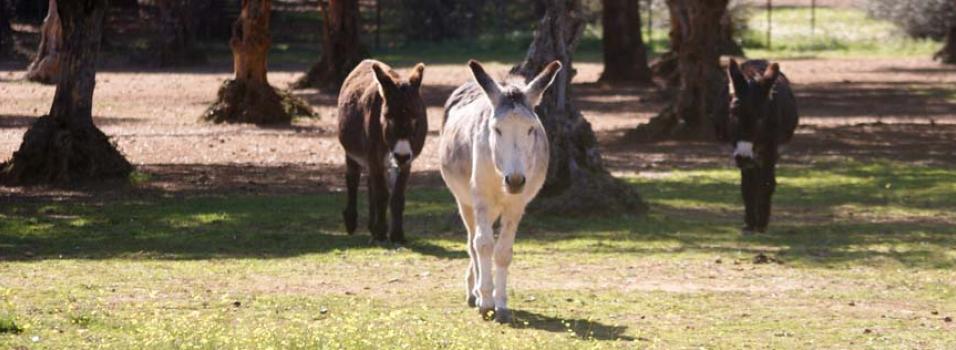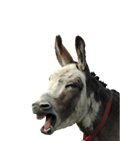Vaccinations for your Donkey
Vaccinations are a safe and effective way of preventing disease in donkeys. In the past vaccinations have often been overlooked or disregarded in donkeys, making them much more vulnerable to diseases.
A ‘primary course’ of injections must be given followed by ‘booster’ vaccinations to keep the protection topped up. The intervals between the injections of the primary course and boosters varies according to the type of vaccine and the disease that they protect against.
Why should vaccinate your donkey?
Vaccination is a reliable method of stimulating your donkey’s immune system. It is the immune system that will help your donkey to fight infection and disease. Vaccines will not always prevent diseases, but they will significantly reduce the symptoms.
Your vet will inject the vaccine into a safe injection site in the muscle, usually in your donkey’s neck or rump.
Donkeys often tolerate vaccinations really well, but some donkeys may be ‘needle shy’.
The ‘needle shy’ donkey may become distressed when approached with a needle and may even become difficult to handle. They will need extra time and care to build their confidence and treats can be a useful distraction. Some donkeys may require more help from a professional, such as a behaviourist.
Very occasionally, donkeys may develop a hot, hard or painful area around the injection site after a vaccination, and even more rarely a donkey may become ill after a vaccination. If you are concerned that your donkey’s behaviour is abnormal or their appetite is reduced after a vaccination then contact your vet for advice.
What should you vaccinate your donkey against?
In El Refugio del Burrito we vaccinate donkeys against equine influenza (flu) and tetanus. Other vaccinations may be considered in pregnant animals or in donkeys that live in countries other than Spain.
Key facts
- Vaccination is a successful way of reducing the risk of certain diseases in donkeys.
- Vaccinations are given as a primary course and kept up to date with booster injections.
- Flu and tetanus vaccinations are available as a combined product so your vet may give one injection to cover both diseases.
- You can check in your donkey’s passport to see which vaccinations your donkey has had and when boosters are due.
- Keeping up to date with your donkeys vaccinations keeps them safe. If a booster is missed, you may need to restart a primary course and this will have an additional cost as well as leaving your donkey with lower protection against disease during this period. Your vet will advise you on the correct frequency of booster vaccinations.
- In some cases, proof of up-to-date vaccination is necessary if you intend to allow your donkey to mix with other equines.
Equine influenza (flu)
Equine influenza, or equine flu as it is commonly known, is a respiratory disease caused by a virus. Equine flu can be spread between horses, ponies and donkeys. It is a different strain to human flu but the symptoms and transmission are similar. It is highly contagious and there is a high risk of disease or even death in unvaccinated animals. It takes one to five days before infected animals start to show symptoms, which can include some of the following:
- Reduction or loss of appetite that can lead to a dangerous condition called hyperlipaemia in donkeys.
- A high temperature, which can last for one to three days.
- Harsh, dry cough.
- Increased effort when breathing.
- Clear, watery nasal discharge that may become thick and yellow or green.
- Swelling of the lower limbs.
Your vet will advise you on when to start the initial course of vaccination and frequency of boosters. This may vary slightly, according to the vaccine used and the risk of disease.
Foals can start the primary course at around six months old or in certain cases from four months old. If you miss booster vaccinations, it is usually recommended that you ‘restart’ your donkey’s vaccines. Your vet will advise you, but this would require a new primary course of equine flu vaccinations.
Tetanus
Tetanus is a devastating disease that is caused by toxins (harmful substances) released by bacteria, which can be found in the soil. It is seen more in certain regions of the UK than in others and horses, ponies and donkeys are more susceptible to infection than other types of animals.
Signs of infection
It may take between three days and three weeks, from the bacteria entering a wound, to see signs of infection. This includes:
- a recent history of a wound including a foot abscess or surgical wound e.g. castration. Note that sometimes a wound is so small that it has healed before you start to see signs.
- stiff or rigid appearance
- excessive reaction to noises or touch
- muscle spasms
- flared nostrils
- third eyelid across the eye
- difficulty breathing
- lying down, may be unable to stand
Most of these cases end in death.
The good news is tetanus is highly preventable with vaccination. Your vet will advise you on primary courses and boosters for tetanus.
Foals can be vaccinated from five to six months old. When foals are born they have some protection passed on from the mother in the first few drinks of milk. It is important pregnant mares are up to date with their vaccinations before they give birth. New born foals are given an injection of tetanus antitoxin (TAT) to protect them against tetanus until they are old enough to be vaccinated.




